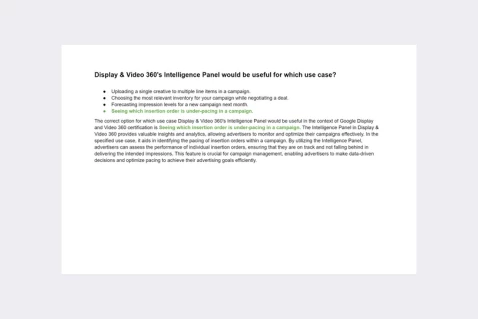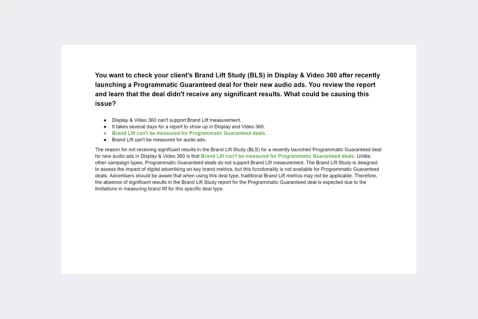You're working on a non-guaranteed deal in Display & Video 360, and your colleague recommends bidding 20% higher than the floor price. In what situation would you consider doing this?
You want to apply frequency management to your deal.
You're working across multiple publishers within a deal.
You're paying in different currencies for a global ad campaign.
You want to guarantee a fixed number of impressions.
Certification program: 👉 Google Display and Video 360 certification exam
Explanation: Bidding 20% higher than the floor price in a non-guaranteed deal within Display & Video 360 is advisable when you’re paying in different currencies for a global ad campaign. Adjusting the bid higher than the floor price helps mitigate potential fluctuations in currency exchange rates. This strategy ensures that the bid remains competitive and aligns with the value advertisers are willing to pay in their local currency equivalents. By implementing this approach, advertisers can enhance the effectiveness of their non-guaranteed deals across various regions and currencies, maintaining a competitive position in auctions and optimizing the campaign’s performance in the context of a global ad campaign with diverse currency considerations.
Passing exams is not a workout. Multiple attempts won’t make you stronger.



- All possible Google Display and Video 360 certification exam questions with answers, and explanations.
- Real certification exam questions
- Detailed answer explanations.
- Reflects exactly the latest real exam questions.
- Free Lifetime updates.
Optimizing Non-Guaranteed Deals in Display & Video 360: Understanding When to Bid Above the Floor Price
Navigating the intricacies of digital advertising often requires a delicate balance between maximizing reach and optimizing costs. When it comes to non-guaranteed deals in Display & Video 360 (DV360), strategic bidding plays a pivotal role in securing desirable ad placements while ensuring efficient budget allocation. In this blog post, we’ll explore the concept of bidding above the floor price, discuss situations where it may be warranted, and share practical insights to aid your decision-making process.
Unveiling the Strategy: Bidding Above the Floor Price
Picture this scenario: you’re collaborating on a non-guaranteed deal in DV360, and your colleague suggests bidding 20% higher than the floor price set by the publisher. At first glance, this recommendation might seem counterintuitive. However, bidding above the floor price can be a strategic maneuver under certain circumstances.
When to Consider Bidding Above the Floor Price
1. Premium Inventory Opportunities
If the non-guaranteed deal presents an opportunity to secure premium inventory placements with high visibility and engagement potential, bidding above the floor price could be justified. Premium placements often command higher bids due to their enhanced value to advertisers.
2. Competitive Landscape
In competitive market environments where multiple advertisers are vying for the same ad inventory, bidding above the floor price can help elevate your bid’s competitiveness and increase the likelihood of winning the auction. This strategy is particularly relevant when targeting high-demand audiences or peak traffic periods.
3. Performance Optimization
When historical data or performance insights indicate that bidding slightly above the floor price yields superior results in terms of click-through rates (CTR), conversions, or return on ad spend (ROAS), it may be prudent to adjust your bidding strategy accordingly. Continuously monitoring and optimizing performance metrics can guide bid adjustments.
4. Campaign Objectives
Aligning bidding strategies with overarching campaign objectives is paramount. If the primary goal is to maximize reach, brand visibility, or audience engagement, bidding above the floor price to secure premium placements and favorable ad positions may be warranted, even if it entails higher costs.
Personal Insights
Throughout my experience in managing digital advertising campaigns, I’ve encountered numerous instances where bidding above the floor price proved instrumental in achieving campaign objectives effectively. By carefully evaluating the unique dynamics of each non-guaranteed deal and considering factors such as inventory quality, competition levels, and performance metrics, we were able to make informed bidding decisions that optimized results while maintaining cost-efficiency.
Conclusion
In the dynamic landscape of digital advertising, strategic bidding is indispensable for optimizing non-guaranteed deals in Display & Video 360. While bidding above the floor price may seem unconventional, it can be a tactical approach in situations where premium inventory, competitive pressures, performance optimization, and campaign objectives align. By leveraging practical insights and data-driven decision-making, advertisers can navigate the complexities of bidding strategies with confidence, ultimately driving greater success in their digital campaigns.
Discover our best-value guides
- Special Bundle Offer Google_Ads_Roll
- Special Bundle Offer HubSpot_Exams_Roll
- Special Offer Unchained_Guru_Roll
- Special Bundle Offer Amazon_Roll
- Special Bundle Offer Google_Analytics_Roll
- Special Bundle Offer Google_SkillShop_Roll
- Special Bundle Offer Marketing_Platforms_Roll
- Special Bundle Offer Microsoft_Advertising_Roll
- Special Bundle Offer YouTube_Roll
- Special Bundle Offer Google_Android_Roll
- Ultimate PMP certification preperation guide
- Google Cloud Professional Architect Certification Exam Answers - Ultimate Guide
- Special Bundle Offer SEMrush_Roll